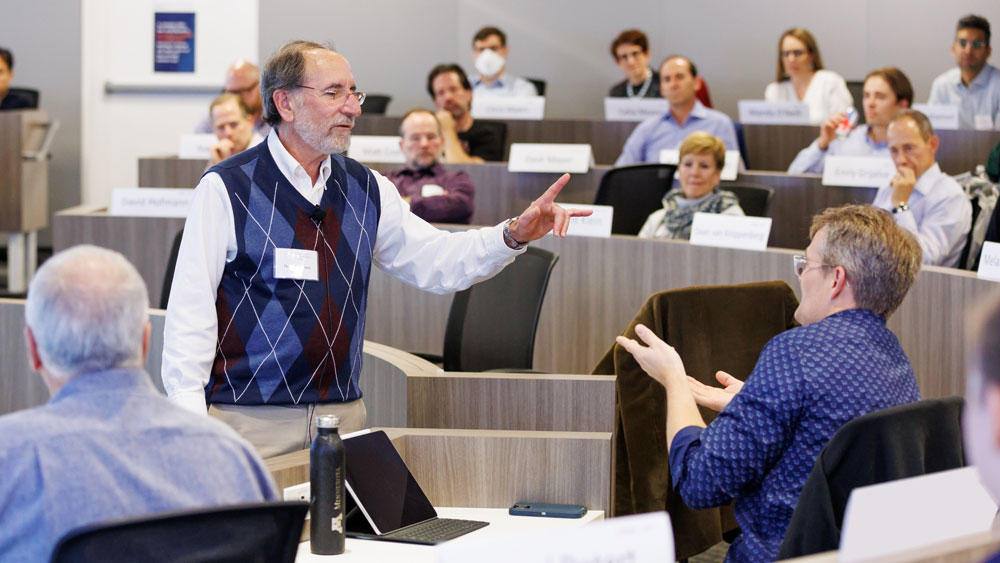
From Animals to AI: New Directions in Leadership Research
By Tom van der Voort
A group of zebras grazes calmly on an African plain. When a lion approaches, the zebras suddenly bolt. The situation sounds simple enough, but a close examination of exactly what happens yields insights into one of the most important aspects of human society: leadership.
The structure of animal societies and the leadership lessons they offer was the focus of the first of three keynote addresses at the annual New Directions in Leadership Research conference, hosted by Darden Professors Jim Detert and Sean Martin in late 2022 at its DC Metro location in Rosslyn, Virginia. Other keynotes examined the quantum leap in artificial intelligence technology and the persistent challenges of mental health. Management professors from around the world also shared findings from their own research, looking for feedback and ideas.

NDLR Conference participants discuss their research
Lessons From the Animal Kingdom

Dan Rubenstein
Professor Dan Rubenstein of Princeton University explained how the physical makeup of various equid species — horses, zebras, and asses — and the specific environmental challenges they face combine to determine how their society operates and the characteristics of successful leader-follower dynamics. His research into animal decision-making helps reveal the “rules” that underlie complex behavior patterns.
In the case of Plains zebras, for instance, their digestive system allows them to consume almost anything. They don’t have to compete for high-quality food, but as a result, they need to eat more of the lower-quality, calorie-light food that’s available. That means they spend a lot of time eating. And when a zebra is eating, its head is down, making it vulnerable to predators.
Any time scanning for threats is time spent away from eating, so it’s best done as a group task. When an individual zebra looks up, she is helping protect the collective. Collectively, the group helps all individuals, allowing each to eat for longer. Both the group and each individual zebra must succeed to maintain cohesion and make the system work.
Plains zebras often live in groups comprised of one male and several females, known as harems, with the males assuming “leadership” in some key ways. Notably, the males don’t succeed by enforcing their will on the group. Instead, the most successful males provide the females with more time to graze, and they fight off any interloping males harassing the females. For this, the males pay a price: They have less time to eat and need to work continually to keep their status high. But when they succeed, the harem assumes its optimal shape and size, balancing individual and collective needs.
 Male Plains zebras also weigh the differing needs of group members. Lactating females are critical to species success, but they need to drink more frequently than non-lactating females, who prefer to spend more time eating. Lactating females often attempt to lead the group to water before others are ready. Male leaders will force the others to go along — but not at first. They wait to minimize the conflict inherent in the situation before prompting the rest of the group to follow, a compromise wherein lactating females end up waiting longer than they want, and non-lactating females stop eating to go drink sooner than they prefer.
Male Plains zebras also weigh the differing needs of group members. Lactating females are critical to species success, but they need to drink more frequently than non-lactating females, who prefer to spend more time eating. Lactating females often attempt to lead the group to water before others are ready. Male leaders will force the others to go along — but not at first. They wait to minimize the conflict inherent in the situation before prompting the rest of the group to follow, a compromise wherein lactating females end up waiting longer than they want, and non-lactating females stop eating to go drink sooner than they prefer.
Finally, there is the group response to a predator. Rubenstein and his colleagues used a “robo-lion” to map exactly how zebras respond to a threat. What appears to be a pell-mell disintegration of the group turns out instead to be a choreographed response. First the zebras orient themselves to the group. Instead of fleeing the lion as individuals, they stay organized to prevent the lion from isolating the weakest link. Mothers and babies are at the front, non-lactating females are distributed in the middle, while the male is most vulnerable at the rear. This coordinated movement helps manage the risks of group survival.

Dan Rubenstein and NDLR participants discuss leadership lessons from animal societies
In sum, Rubenstein said, the lessons from the animal kingdom are three: Leadership depends on context: environment, needs, resources, and challenges. Leaders rely mostly on self-organized, bottom-up strategies, taking their cues from the group. And leadership works best if conflict is reduced. African proverbs often reflect the wisdom found in this model of leadership, reminding us that “the roaring lion kills no prey” and “the fate that befalls the lowly will befall the leader.”
AI’s Rapid Evolution

Mark Beall
Leaving the world of animals, participants found themselves at the opposite end of the technology spectrum during the presentation of Mark Beall, cofounder and CEO of Gladstone AI, who discussed rapid advances in artificial intelligence.
AI combines computational power, with data and algorithms to make predictions and execute tasks. Only in the last 18 months, however, has AI begun to move beyond highly specialized narrow tasks to more general activities. These advanced AI capabilities allow machines to mimic humans in ways that are only just beginning to unfold, with complicated assignments such as writing, speaking, and image creation, as well as the ability to learn rapidly.
More on DARDEN IDEAS TO ACTION: The Shifting Economics of AI
This growing power offers huge opportunities to create value, but the paths forward are anything but obvious. Rapid change also brings challenges as human tasks increasingly become the domain of machines. Changes wrought by computers and the internet were hugely consequential to business and society, and leaders must think about AI on the same scale. Managing this seismic change simply cannot be deferred to CTOs and tech teams.

AI-generated faces from fotor.com
New security threats will also challenge leaders as AI becomes more capable. “Phishing” attacks are just one example. Today, these attacks are broad but generally unsophisticated and easy to spot with awareness and a few simple techniques organizations can teach their employees. “Whaling” attacks are just the opposite. They are narrowly targeted to specific individuals, highly sophisticated and hard to detect. While phishing takes little time to deploy and relies on reach, whaling attacks take time and energy as perpetrators design strategies to compromise specific individuals.
AI could soon eliminate this distinction, enabling machines to create sophisticated whaling attacks deployed at the scale of phishing — communications that are so believable they are nearly impossible to counter with current strategies. To get ahead of the curve, leaders need to become AI literate and start thinking more carefully about these challenges now.
The Ultimate “Human Resource”

Barbara Van Dahlen
Even as AI begins to display many traits of human behavior, however, humans themselves still drive organizations and still contend with very human problems. Dr. Barbara Van Dahlen, co-chair, co-founder and chief executive officer of WeBe Life Inc., highlighted one of the most important challenges facing leaders when she discussed “an unprecedented mental health crisis affecting every business and every sector.”
The topic of mental health has certainly gained interest in recent years, said Van Dahlen, but the conversation still comes up short of dealing with the stark reality. Untreated mental health issues account for 13 percent of the total burden of all disease. Poor mental health, which costs the world economy $2.5 trillion today, is on track to account for $6 trillion in lost productivity by 2030.
And then, of course, there’s the human suffering that comes with mental illness. Most Americans lack access to adequate care; there are long delays between the onset of symptoms and treatment; 56 percent of American adults with mental illness did not receive adequate care within the past year. If we include problems that fall short of clinically diagnosed mental illness, some studies suggest that as many as half of U.S. workers suffer from mental health issues.
Driving the crisis are a failure to prioritize mental health, limited resources to provide care, an unsustainable service delivery model, and inadequate and poorly constructed infrastructure. With such a tremendous loss of value on the table, a search for innovative solutions is the job of every leader.
The first step is for leaders to educate themselves about the current global mental health crisis and its impacts. They can acknowledge suffering, offer compassion, and share their own experiences. Leaders must also be critical of their own organizations, identifying how the culture may contribute to mental health struggles. And they can respond by instituting practices that support emotional health and well-being.
Those who study leadership can make all these efforts more effective by understanding how best to develop emotionally healthy leaders, the individuals who will play a key role in addressing the mental health challenges of the future.
The University of Virginia Darden School of Business prepares responsible global leaders through unparalleled transformational learning experiences. Darden’s graduate degree programs (MBA, MSBA and Ph.D.) and Executive Education & Lifelong Learning programs offered by the Darden School Foundation set the stage for a lifetime of career advancement and impact. Darden’s top-ranked faculty, renowned for teaching excellence, inspires and shapes modern business leadership worldwide through research, thought leadership and business publishing. Darden has Grounds in Charlottesville, Virginia, and the Washington, D.C., area and a global community that includes 18,000 alumni in 90 countries. Darden was established in 1955 at the University of Virginia, a top public university founded by Thomas Jefferson in 1819 in Charlottesville, Virginia.
Press Contact
Molly Mitchell
Associate Director of Content Marketing and Social Media
Darden School of Business
University of Virginia
MitchellM@darden.virginia.edu



